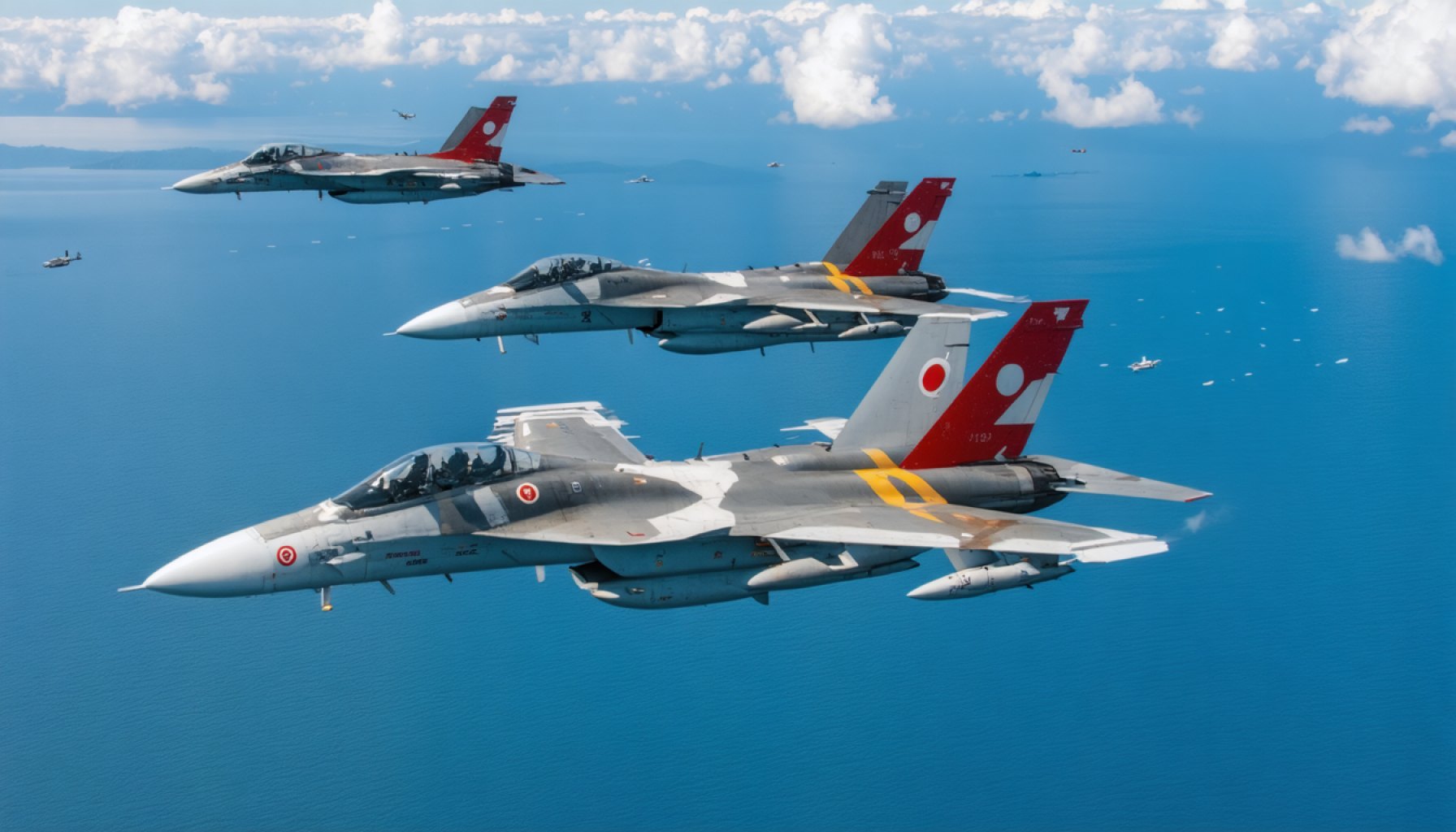- Japan’s Air Self-Defense Force recorded 30 interactions with Chinese drones over the Nansei Islands, marking a strategic escalation.
- China’s military drones, including TB-001, BZK-005, and GJ-2, frequently traverse the skies near Japan, reflecting Beijing’s expanding military interests.
- The Nansei Islands, especially Yonaguni Island, are focal points for these encounters due to their proximity to Taiwan.
- These incursions underscore China’s aim to monitor or assert control over the First Island Chain, pivotal to its defense strategy against the U.S.
- Japan remains vigilant, bolstering alliances with democracies sharing concerns over Beijing’s maneuvers.
- Japan’s strategic response emphasizes defense, alliances, and dialogue to counterbalance tensions in the region.
- This aerial activity signifies the broader geopolitical stakes in the Pacific, affecting global discourse and security dynamics.
The skies above the Nansei Islands have become a dramatic stage, where a new form of aerial chess unfolds. In the past fiscal year, Japan’s Air Self-Defense Force engaged a record-breaking 30 times with Chinese military drones, underscoring a significant escalation in the Pacific’s strategic ballet.
Imagine Japan’s F-15s and F-2s cutting through windswept skies, propelled by urgency and precision, as they respond to the teasing presence of China’s unmanned aerial vehicles. These drones, sleek and silent, skim through international airspace near Japan’s southwestern islands, carving paths that signal Beijing’s expanding military ambitions.
The Nansei Islands stretch like a fragmented green ribbon from Japan’s southernmost tip near Kagoshima to Okinawa. But it’s Yonaguni Island, perilously close to Taiwan — just 68 miles away — that bears witness to frequent Chinese drone crossings on groaning Pacific winds.
China’s interest in this island chain reflects its deeper strategic calculus. Each drone sortie reaffirms its determination to monitor or possibly control the First Island Chain, a critical line of defense against its rivals, chiefly the United States. These sorties often routinize crossings between Yonaguni and Taiwan, highlighting Beijing’s interest in the waters that envelop Taiwan, a geopolitical touchstone for both China’s aspirations and Washington’s commitments.
Highlighted within these maneuvers are the TB-001, BZK-005, and GJ-2 drones, whose silhouettes have become increasingly familiar to Japanese radar operators. Their routes span vast oceanic expanses, from the East China Sea’s mutable blue to the open courts of the Pacific, often looping over key points like Amami Oshima.
On early June mornings, a TB-001 drone might glide between Okinawa and Miyako, skimming the rhythmic tide lines before charting a course northward. Analysts see these routes as China’s systematic expansion of military theater—to keep Japan and its allies on alert and to test the reflexes of defensive networks humming quietly beneath radar domes.
Amid such incursions, tensions flutter over the East China Sea’s disputed boundaries. The presence of China’s Coast Guard vessels, audaciously venturing into Japanese territorial waters, reveals the multi-layered contest for sovereignty between Japan’s serene Senkaku Islands and China’s fervently claimed Diaoyu.
Japan remains vigilant yet measured, echoing its defense strategies not only in interception but in cultivating alliances with nations sharing democratic values and mutual concerns over Beijing’s posturing. Nakatani Gen, Japan’s defense minister, emphasizes the gravity of these tactical provocations which ripple across the international stage, urging a collective response steeped in dialogue and deterrence.
In this dynamic mix of human technology and geopolitical ambition, Japan stands as a sentinel in a theater where skies are no longer just expanses of freedom but canvases of calculated maneuvers. This engagement with China is more than about UAVs in airspace; it’s about maintaining stability in a region where history and future converge on uncertain winds.
Japan’s intercepts serve as a reminder: As digital eyes and composite wings patrol vast distances, what transpires in these skies resonates far beyond their boundaries, rippling across global discourse and strategic calculus.
Why the Skies Over the Nansei Islands Are the New Flashpoint in Asia’s Geopolitical Chess Game
A Surge in Aerial Encounters
Japan’s Air Self-Defense Force is deeply engaged in a strategic mission, intercepting Chinese military drones over the Nansei Islands. This situation marks a significant shift in regional power dynamics, with a record 30 such encounters reported in the past fiscal year. Each interaction echoes the increasing tension between the two Asian powers, with broader implications for regional stability.
Unpacking the Geopolitical Context
1. Strategic Importance of the Nansei Islands:
– Stretching from Kagoshima to Okinawa, the Nansei Islands are a key strategic frontier for Japan. They lie closely positioned to Taiwan, only 68 miles from Yonaguni Island.
– The islands are part of the First Island Chain, a critical line of defense against Chinese expansion in the Pacific.
2. China’s Expanding Military Ambitions:
– The routes taken by Chinese drones such as the TB-001, BZK-005, and GJ-2 highlight Beijing’s goals in the region, often passing through critical areas like Amami Oshima.
– These flights are systematic attempts to expand China’s military theater and test the responses of Japan and its allies.
3. Reaction and Defense Measures:
– Japan utilizes F-15 and F-2 fighters to intercept and monitor these drones, signaling to Beijing its readiness to defend its airspace.
– Coordination with U.S. forces and other allies emphasizes a collective defense strategy focusing on deterrence and diplomacy.
Real-World Implications and Trends
How-To Steps for Regional Stability:
– Fostering Alliances: Japan should continue building stronger ties with democracies in the region to form a unified front against Chinese aggression.
– Enhancing Surveillance Capabilities: Investing in advanced radar and satellite technology will better equip Japan to detect intrusions.
– Regular Military Drills: Conducting joint exercises with allied nations can strengthen defense readiness and interoperability.
Industry Trends:
– Increased UAV Development: Global markets are witnessing a surge in the development and deployment of more advanced UAVs for military use.
– Integration of AI in Defense: Artificial intelligence is increasingly being integrated into military systems for more robust surveillance and response capabilities.
Insights & Predictions
– Short-term: Expect an increase in diplomatic dialogue between Japan, China, and other regional players aimed at reducing tensions.
– Long-term: Regional powers may invest more in missile defense systems and high-tech surveillance to manage future incursions.
Conclusion: Actionable Recommendations
1. Stay Informed: Citizens should keep abreast of the evolving geopolitical landscape in the Pacific.
2. Support Defense Initiatives: Public backing for initiatives that enhance regional security and stability is crucial.
3. Engage in Dialogue: Advocacy for diplomatic solutions over military escalations can contribute to peaceful resolutions.
Explore Related Insights
For further information and updates on geopolitical developments, visit Chatham House and RAND Corporation.
This dynamic geopolitical stage reflects not just a battle for the skies, but a contest for influence. Understanding and addressing the complexities of these aerial encounters can help ensure peace and stability in the Asia-Pacific region.







